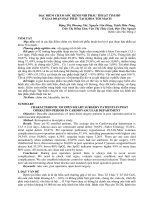Chăm sóc Điều Dưỡng Phẫu thuật sọ não (bản tiếng Anh) ppsx
Bạn đang xem bản rút gọn của tài liệu. Xem và tải ngay bản đầy đủ của tài liệu tại đây (895.28 KB, 38 trang )
Care of the Client with
Cranial Surgery
Kathleen Ohman, RN, CCRN, EdD
Developed in cooperation with Kim Scott, RN, MSIndications for Cranial Surgery
Intracranial infection (abscess) - usually
staphylococci or streptococci. Cranial surgery
performed to open and drain abscess
Epilepsy - Cranial surgery to remove the epileptic
focus for patients whose epilepsy cannot be
controlled by drug therapy
Skull fractures - for depressed fracture or fracture
with loose fragments. Cranial surgery necessary to
elevate depressed bone and/or remove fragments
Indications for Cranial Surgery
Brain Tumors
Steriotactical techniques used to perform biopsy
and/or remove small tumors
Location and type determines if surgical removal
possible
Tumors located in deep central areas of brain
inoperable
Cranial surgery performed if tumor is removable
Brain Tumors (cont.)
Primary tumors - arise from tissues in the brain
Secondary tumors - result from metatastisis from malignant
neoplasm elsewhere in body
Gliomas account for 65% of primary tumors (malignant)
Astrocytoma- most common glioma
Oligodendroglioma-often localized frontally
Glioblastoma multiforme highly malignant and invasive
Meningioma and Pituitary tumors
Benign
Tend to recur
Unless treated, all tumors cause death from increased tumor
volume leading to increased ICP
MRI showing a meningioma crossing the tentorium on left
Indications for Cranial Surgery
Intracranial bleeding
Indications for Cranial Surgery
Hydrocephalus
Overproduction, malabsorption, or accumulation
of CSF. Shunting procedure performed to drain
CSF.
Hydrocephalus (cont.)
AVM (Arteriovenous
malformation)
Aneurysm Repair
A clip is placed across the neck of the aneurysm which
originates from the carotid artery
Preoperative teaching to patient and family
•
Explain preop labs, tests, procedures
•
Explain anesthesia, estimated length of procedure,
how long in recovery and where will go after
recovery (ICU)
•
Explain how pt. will look after surgery
•
Explain what to expect postoperatively re: dressings,
catheter, ET tube, Foley, IV’s, IS, pain management
Preoperative nursing
management
Preoperative nursing
management (cont.)
Nearest relative may need to sign consent
Scalp prep - hair shaved (save hair) to reduce
risk of infection and provide better exposure
Baseline neuro assessment
Family anxious re: potential physical and
emotional deficits related to surgery -
compassionate preoperative nursing care
Types of Cranial Surgery:
Burr Hole
-to remove blood/fluid or in
preparation for a craniotomy
Types of Cranial Surgery:
Craniotomy
Craniotomy (cont.)
After the dura has been stitched closed, the piece of bone is replaced and
sutured into place. An ICP monitoring device may then be implanted.
Craniotomy (cont.)
Types of Cranial Surgery:
Craniectomy
Shunt Procedures
While the patient is deep asleep and
pain-free (using general anesthesia),
a flap is cut into the scalp, and a small
hole is drilled in the skull.
Shunt Procedures (cont.)
A small catheter is passed into a
ventricle of the brain. A pump is attached
to the catheter to keep the fluid away
from the brain. Another catheter is
attached to the pump and tunneled
under the skin, behind the ear,
down the neck and chest, and into the
peritoneal cavity (abdominal cavity).
The CSF is absorbed in the
peritoneal cavity.
Minimally Invasive Cranial Surgery
A preoperative cerebral arteriogram (A) shows a basilar tip
aneurysm. A postoperative arteriogram, after aneurysm clipping
via a superolateral orbital craniotomy, confirms successful
clipping (B). A patient with a healed superolateral orbital
craniotomy incision line (C) (arrows).
Stereotaxis
Advantages:
•
non-invasive
•
less risky than crani-
otomy
•
decreased cost
•
decreased length of
stay, recovery
"stereotactic radio surgery”- removing tumors with radiation to a
specific target, without radiating the entire brain
Cranial Surgery
Primary Goal of Care - prevention of
increased ICP
Ventriculostomy
Drains CSF
Allows for intraventricular drug administration
Measures pressure within vessels









